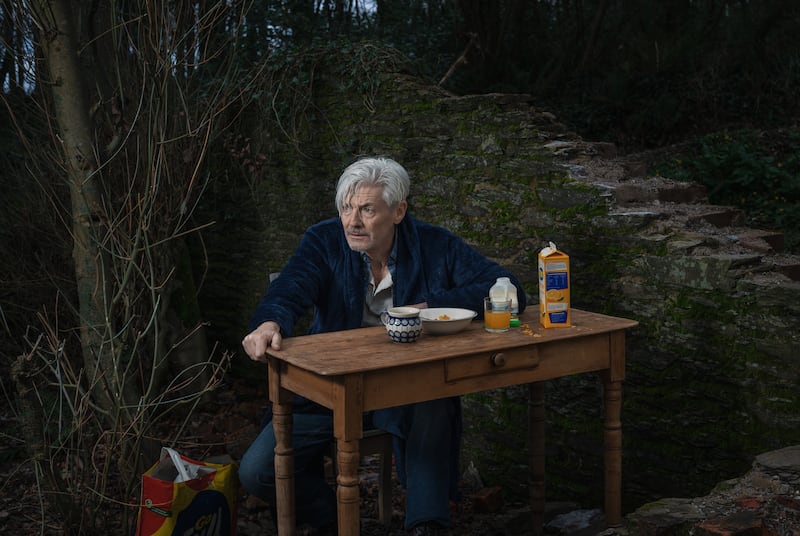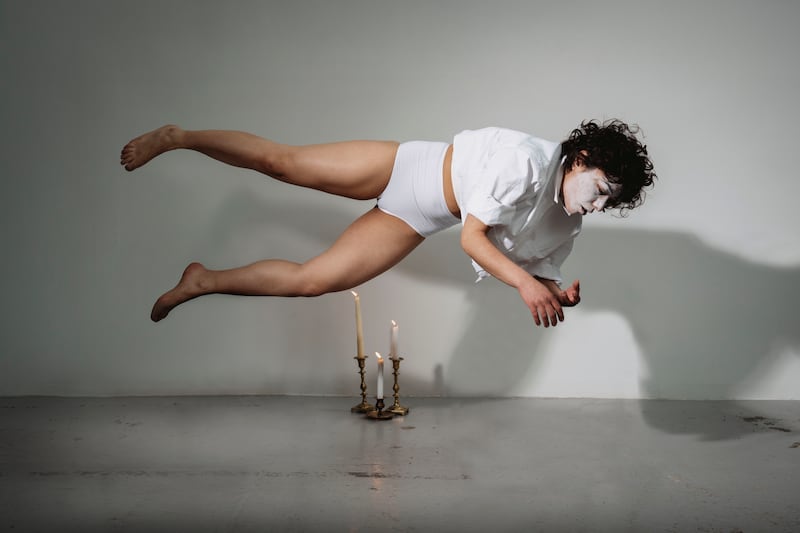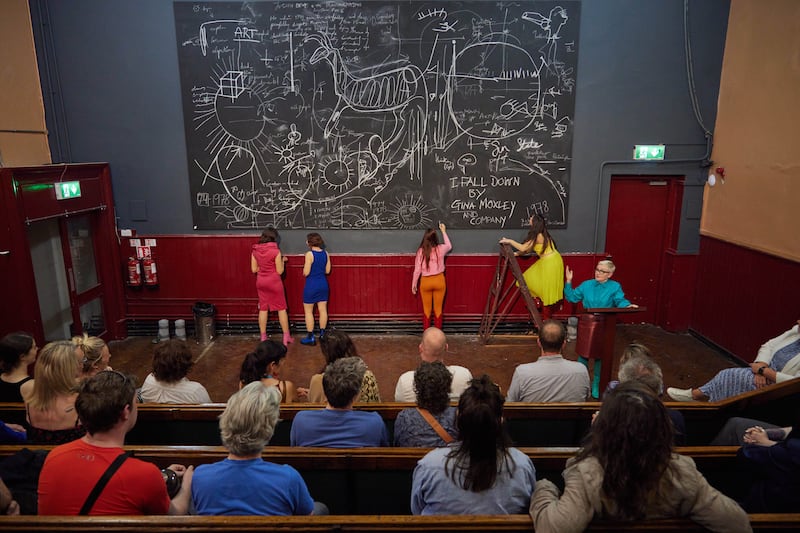Slowly the chorus from Mayfield Men’s Shed enter with night-lights glowing from the kind of boats we made with paper long ago. Slowly they sway as if matching a sea swell, their humming voices repeating the homing mantra: Statio Bene Fida Carinis. A Safe Harbour for Ships. It remains, even as Cork’s maritime history is being sheared from its heart and heartlands, a local legend, just as, for Sean O’Faolain, it was “the first Latin I loved to mouth” (An Irish Journey 1940).
Presented as part of Cork Midsummer Festival, Built on Bridges (★★★★★) is the final work from Helga Deasy as Cork city’s artist-in-residence at Dance Cork Firkin Crane. It emanated from her engagement with Music Alive’s Creative Enquiry scheme and the Arts Council’s Invitation to Collaboration programme, so perhaps it is not rare for such a scheme to result in a work that uses creativity, inquiry and collaboration to such an impact that when this performance ends there is that moment of silence in which an audience can gather its emotional wits before rising unanimously in applause.
On Jenny Whyte’s set of cloudlike rocks, washed in blue from Tim Feehily’s lighting design, a dancer floats his paper galleon; Kevin Hayes, Sara Hernandez and Yumi Lee dance together as passengers enduring passage from parting to tempest to calm; a bell sounds from some lonely rock, and the soundscore by Fiona Sheil swells and falls as if the ancient mariner himself were lurking on the rigging.
As soloists the dancers bring Deasy’s work to ardent life on a stage decorated with a frieze falling like a pergola of tiny swans, golden in the light. More swans come in as birds carried in pairs by children selected from an open call; they flock and rise in their papery gatherings in this evocation of the beating lift, the gliding descent, the silent disappearance. It isn’t Swan Lake, but it is swanlike and it is bewitching.
READ MORE
Magic is no accident. This is a structured work. Choreography, direction, set and costumes, music and voice, dance and lighting, allusions and imagination: nothing is random or merely effect without resonance. The Men’s Shed choir is conducted by Susan McManamon; the music and lyrics for Statio Bene are by Liam Christopher O’Leary. Under Deasy’s direction and Eoin Ó hAnnracháin’s production there is a unity of purpose, a company assembled more like a congregation than a collaboration. Perhaps this is why we experience the performance as a haunting. The tears we note as we exit are not nostalgia for a fading city but recognition of this exquisite obsequy.

The title of The Settling (★★★★☆), by Gavin McEntee, which gets its world premiere at the Granary, suggests something arranged or concluded. Yet at the apparent conclusion of this startlingly energetic play nothing is decided, in that there is a sense of continuance rather than of finality. Because the physical agility of Raymond Keane as A Man and Katie Honan as A Girl is so remarkable, and so remarkably related to their flow of conversation, that the attention needed to decode what they are saying or referencing to one another is deflected. Then a linkage emerges between the dots, at least until the dots resemble something more like a cat’s cradle than a map.
Delivered with a necessary ballast of comic wit, this web of words involves great skill in the writing and in the speaking; gradually the metaphoric weight of the play comes closer to the surface, helped by the frantic set from Deirdre Dwyer – who also directs – and the lighting design by Sarah Jane Shiels. Man and Girl exist in a symbiosis both toxic and sustaining, he in a tenement-like bedroom and she hiding in a rubbish bin when not digging what may be a grave in the carpet.
His family want to sell the building; he cowers at the sight of a document presented by the woman who visits to feed and wash him and to change the sheets. What will be revealed if the builders move in? Does the girl exist at all? Or perhaps she has done and is now a slight but talkative ghost of other slight young ghosts before her. Honan gives her a fluent presence to lighten, or perhaps occasionally to darken, Keane’s two-thirds-demented life.
The power of insinuation is McEntee’s great talent. The implications multiply or dissolve in a cascade of possibilities, small and personally tragic, large and nationally cataclysmic. The velocity of the dialogue hides the clues in its pauses: was another little girl here? Is she fairy or a baby banshee? Has he told the wrong story after all their stories? Although the suggestion of a resolution through reclaimed motherhood and loss is not convincing despite George Hanover’s grieving monologue, there is so much to excavate through banter, wordplay, song and sadness that one exits this BrokenCrow production, which is staged in association with the Everyman and Cork Midsummer Festival, captivated and definitely unsettled.

The world premiere of Ritual (★★★☆☆) from Junk Ensemble, at the Marina Market Warehouse, is a performance installation created by Jessica Kennedy and Megan Kennedy to music from Irene Buckley and choreography by a collaboration with the dance artists Salma Ataya, Lucia Kickham and Julie Koenig. Lighting by Sarah Jane Shiels, assisted by reluctant matches, leads the promenade audience from area to area within the wide floor space where figures coil and uncoil until, moving from a floored circle of slowly moving images, the gathering Byzantine intimations of what may be a crusade culminate in the high swinging of an immense thurible releasing its mist of incense. Perhaps we have been on a pilgrimage – when everything is on the same level it can be difficult to see exactly what’s going on, although the percussionist Caitríona Frost helps along the camino way.

Gina Moxley is a good fit for Cork Midsummer Festival, having just the touch of outrageous comedy that separates the comic sheep from the goats – or, as in this case, the adults from those under 16. Even those a little over 16 plus might flinch at the thought of the reproduction of intimate female body parts as integral to I Fall Down: A Restoration Comedy (★★★☆☆), at Crawford Art Gallery. As a former student of what was then called the School of Art, Moxley revives her indignation at the omission of women artists from her history-of-art syllabus in those faraway days when students weren’t supposed to be indignant about anything.
Moxley’s own art history is erudite enough to give this performance, directed by John McIllduff, solid grounding. Her mischievous élan, along with the singing of the soprano Amy Ní Fhearraigh and the supple choreography of Emily Terndrup, brings her audience through inner spaces already showing signs of the decant under way for the coming building work at the Crawford. But here we are at the Boboli Gardens looking for the naked truth of statuary; Moxley has extended her search from omitted painters to omitted private parts.
As her counteroffensive, the audience are encouraged to ignore the sculptural difficulty of rendering invisible anatomy and instead are instructed to reproduce, as if for a gynaecological aide-memoire, those most sensually important elements of a woman’s body. And with not a wince or a flinch among them they do, this time not in marble but in playdough.
Cork Midsummer Festival continues until Sunday, June 25th; Built on Bridges, Ritual and I Fall Down have finished their runs; The Settling ends on Thursday, June 22nd












